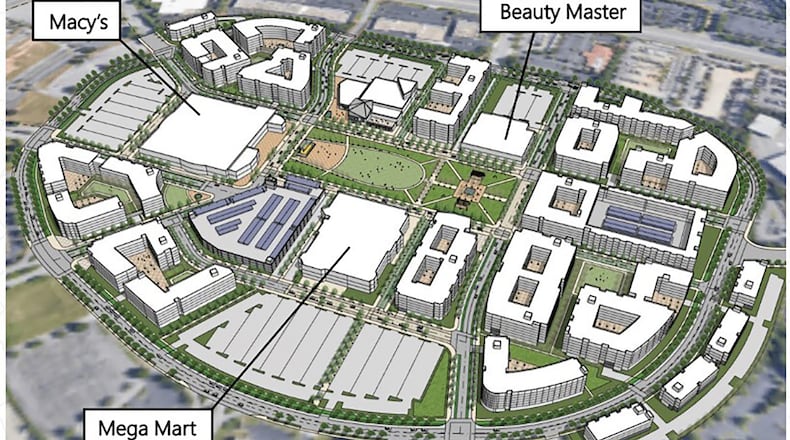The team revitalizing the dilapidated Gwinnett Place Mall recently released a conceptual design that is more residential, with less retail and office space, than earlier draft plans.
The area around the 90-acre site, off Interstate 85 south of Duluth, is saturated with retail and empty office space, according to a market analysis conducted as part of the site revitalization process. Meanwhile, more than 500,000 people are projected to move to Gwinnett over the next two decades, many seeking walkable housing with an urban feel, said Joe Allen, executive director of the Gwinnett Place Community Improvement District.
“They’re going to need a place to call home, and what better place than Gwinnett Place?” Allen said.
The site revitalization team includes the CID as well as officials from the county, Atlanta Regional Commission and the planning firm Vanasse Hangen Brustlin.
They named the mixed-use redevelopment concept “Global Villages,” highlighting its location in the most diverse neighborhood of the most diverse county in the South.
The development will center on a park and a cultural center that could host events, an international library and incubator space for entrepreneurs from underrepresented backgrounds, Allen said. Most of the existing mall would be demolished, but Macy’s, Mega Mart and Beauty Master would remain in their buildings.
The design includes seven residential villages with a total of 2,700 units of multi-family housing. Each village will contain small plazas and trails to the central park. The team plans to mix affordable or workforce housing with market-rate units, but those details are still being determined, Allen said.
The plan includes between 50,000 and 100,000 square feet of new retail, focused on international restaurants and cultural stores, and a parking structure with no more than five floors. It includes 25,000 square feet of commercial office space, half of what was previously proposed, likely to be flexible co-working spaces instead of large towers.
Allen said the roads at the site would include bike and transit lanes, sidewalks and crosswalks. Ring Road, which circles the sea of surface parking surrounding the mall, would become a greenway trail. The site would connect to the countywide trail network via McDaniel Farm Park and Venture Parkway.
A new transit center, set to become Gwinnett County’s bus hub, is in the design phase just west of the mall site. The county is also studying a proposed bus rapid transit line that could link the site to the Jimmy Carter Boulevard and Sugarloaf arteries.
Gwinnett Place Mall opened in 1984 and was considered the unofficial downtown of the county until the new millennium, when it began to decline. The county gained control over the mall’s redevelopment when it bought 39 acres of the property last year for $23 million. The three remaining box stores own their buildings and parking lots, and the project will include negotiations with them, officials have said.
The county would build the cultural center, central park, parking garage, greenway trail and other transportation improvements, while private developers would build the villages, the site team said.
Despite the largely residential redevelopment plan, the area will still thrive commercially, Allen said. There are more than 170 restaurants in the area that people largely drive to, he said.
“It’s still an economic engine for the community, but what it’s lacking are people to call it home,” Allen said. “Wouldn’t it be great if we could create a place where people could live, work, dine, play, almost without having to get in a vehicle?”
Allen estimated redevelopment would take about a decade. The site team plans to submit an implementation strategy, including estimated costs and timelines, to the county Board of Commissioners by the end of the month.
About the Author
Keep Reading
The Latest
Featured



